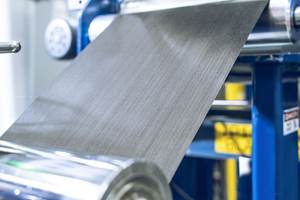Automotive evolution or real revolution?
HPC's editor-in-chief Jeff Sloan asks, Are efforts by BMW and GM to put carbon composites in cars a harbinger of things to come, as we hope, or flashes in the pan?
As we went to press in mid-December with this issue of HPC, Tokyo-based fiber manufacturer Teijin Ltd. and automaker General Motors (GM, Detroit, Mich.), announced an agreement under which the two companies will codevelop a Teijin high-speed process for the manufacture of carbon fiber-reinforced thermoplastic structures for use in a production vehicle.
Teijin said it will build a new technical center somewhere in northern North America (location to be announced early this month) where GM and Teijin will test and fine-tune Teijin’s high-speed thermoplastic composites manufacturing process.
We caught wind of Teijin’s new process just before the JEC Composites 2011 show last year. The company was not fully forthcoming about details of the process, but did report that it is a press-forming system, and that the fiber is prepregged and could be used with almost any thermoplastic matrix, including polypropylene and polyamide. This past spring, developed material forms included unidirectional intermediate-modulus fabric, isotropic intermediate-modulus fabric and long-fiber thermoplastic pellet. And Teijin reported that its press-forming process features a cycle time of just 60 seconds. This is important because the automotive world’s part-per-minute cycle time has long been considered one of the enduring standards composites must meet before automakers will embrace them as a structural materials.
GM’s Jim Hentschel, executive director and global functional leader for Body, Exterior and Dimensional Engineering, told HPC the carmaker has a particular resin and fiber combination in mind but would not identify them. The carmaker also was reluctant to commit to a timeline for development, but Hentschel did say that GM is excited and eager to move forward and help reduce weight on its vehicles. “We moved very quickly on this,” he said, “and it shows that GM is very open to new and emerging technology.”
What remains to be seen is how extensively GM will integrate these thermoplastic composite structures in a new vehicle. Greg Hagy, director of business development at GM, told us that the company plans to “engineer from the ground up” to optimize composites use in next-generation vehicles. They’re not, we report with some relief, expecting “black aluminum.”
GM’s announcement comes on the heels of three others:
- Over the past 18 months, BMW (with the help of carbon fiber maker SGL Group) has worked to develop carbon fiber composites for its all-electric i3 and the hybrid-electric i8.
- In November 2011, carbon fiber manufacturer Zoltek launched prepreg operations for automotive applications, following the 2010 launch of Zoltek Automotive Inc., to focus on high-volume applications for carbon fiber composites in cars and trucks.
- In Japan, in late 2010, carbon fiber supplier Toray and Toyota announced a joint effort to develop carbon composites and processes for body panels on some Lexus models.
Taken together, these announcements make one wonder — hopefully — if these carmakers are only the first of many that will take the bold step of integrating carbon fiber composites into production vehicles. As 2012 begins, it will be interesting to see what other automakers do to meet the challenge these carmakers present. And to see what sort of challenge it is. Do these announcements signal that we are on the cusp of a paradigm shift in automotive manufacturing? Or are we witnessing a few intriguing, but isolated, outside-the-box experiments with advanced materials that might forever remain outside the production mainstream? Only time will tell, but it’s the difference between automotive evolution and a real revolution.
Related Content
JEC World 2022, Part 3: Emphasizing emerging markets, thermoplastics and carbon fiber
CW editor-in-chief Jeff Sloan identifies companies exhibiting at JEC World 2022 that are advancing both materials and technologies for the growing AAM, hydrogen, automotive and sustainability markets.
Read MoreOne-piece, one-shot, 17-meter wing spar for high-rate aircraft manufacture
GKN Aerospace has spent the last five years developing materials strategies and resin transfer molding (RTM) for an aircraft trailing edge wing spar for the Airbus Wing of Tomorrow program.
Read MoreCycling forward with bike frame materials and processes
Fine-tuning of conventional materials and processes characterizes today’s CFRP bicycle frame manufacturing, whether in the large factories of Asia or at reshored facilities in North America and Europe. Thermoplastic resins and automated processes are on the horizon, though likely years away from high-volume production levels.
Read MoreDemonstrating composite LH2 tanks for commercial aircraft
Toray Advanced Composites and NLR discuss the Netherlands consortium and its 4-year project to build demonstrator liquid hydrogen tanks, focusing on thermoset and thermoplastic composites.
Read MoreRead Next
From the CW Archives: The tale of the thermoplastic cryotank
In 2006, guest columnist Bob Hartunian related the story of his efforts two decades prior, while at McDonnell Douglas, to develop a thermoplastic composite crytank for hydrogen storage. He learned a lot of lessons.
Read MoreCW’s 2024 Top Shops survey offers new approach to benchmarking
Respondents that complete the survey by April 30, 2024, have the chance to be recognized as an honoree.
Read MoreComposites end markets: Energy (2024)
Composites are used widely in oil/gas, wind and other renewable energy applications. Despite market challenges, growth potential and innovation for composites continue.
Read More


























